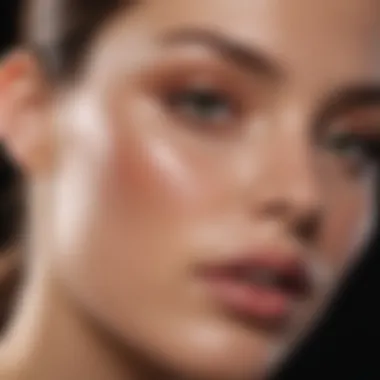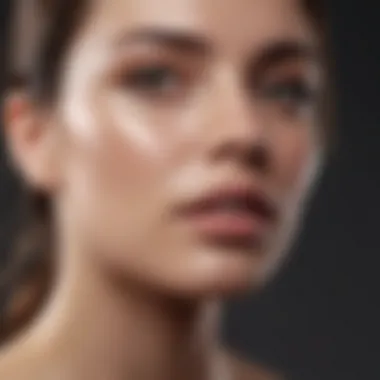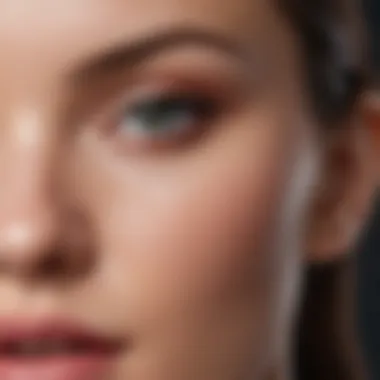Expert Tips for Choosing the Best Primer for Long-Lasting Makeup


Beauty Trends
In the ever-evolving landscape of beauty trends, the quest for the perfect makeup look is unending. From dewy skin to bold lip colors, women of all ages are seeking ways to enhance their natural beauty. When it comes to achieving a flawless and long-lasting makeup look, using the right primer is key. Here, we delve into the intricate world of primers, unravelling the essential role they play in makeup application and longevity.
The Importance of Primers
Primers act as a crucial bridge between skincare and makeup application. By creating a smooth canvas for foundation and other products, primers help in minimizing pores, reducing shine, and ensuring makeup adheres well to the skin. Women are constantly on the lookout for primers that not only extend the wear of their makeup but also provide added benefits like hydration, SPF protection, or color correction.
Factors to Consider When Choosing a Primer
Skin Type and Concerns
Before selecting a primer, it's imperative to assess your skin type and concerns. Whether you have oily, dry, combination, or sensitive skin, there's a primer formulated to address your specific needs. For those battling redness or discoloration, color-correcting primers can be a game-changer, while hydrating primers work wonders for dry skin.
Ingredients and Formulation
Pay attention to the ingredients in the primer. Look for formulations that are non-comedogenic, free of harsh chemicals, and contain beneficial components like hyaluronic acid, antioxidants, or botanical extracts. It's essential to choose a primer that not only enhances makeup longevity but also nourishes and protects the skin.
Finish and Effect
From mattifying primers that combat excess oil to illuminating primers that impart a radiant glow, the finish and effect of a primer play a significant role in the final makeup look. Consider your desired finish - whether you prefer a velvety smooth base or a luminous sheen - and select a primer that aligns with your aesthetic goals.
Choosing the Right Primer for You
After delving into the intricacies of the different types of primers available in the market and understanding the key factors to consider, it's time to embark on the journey of finding the perfect primer for your makeup routine. Experiment with various textures, formulations, and finishes to determine which primer seamlessly integrates into your beauty regimen, offering both performance and skin benefits.
With the right primer as your beauty ally, you can unlock a world of endless makeup possibilities and ensure your looks stay impeccable from day to night.
Closure
Understanding the Importance of Primers
Primers constitute a crucial element in makeup application. Their significance lies in their ability to create a unified base for cosmetics, improving their lasting power and overall finish. By serving as a preparatory layer, primers ensure that makeup adheres effectively to the skin for an extended period. Understanding the importance of primers is essential for achieving a seamless and durable makeup look. Selecting the right type of primer according to one's skin type and makeup preferences is paramount for a flawless finish.
What Are Primers?
In the realm of makeup, primers act as a foundational product that aids in enhancing the longevity and appearance of cosmetics. They serve as a link between skincare and makeup, offering multiple benefits for a refined finish. The definition of primers in makeup encapsulates their role in prepping the skin before the application of makeup products. By creating a smooth base, primers assist in concealing imperfections and ensuring a uniform makeup application.
- Definition of primers in makeup: Primers are formulations designed with unique ingredients to prepare the skin for makeup application. They work as a barrier between the skin and cosmetics, enhancing the adherence and longevity of makeup.
Primer's role in makeup is akin to a foundation for building a house, providing a stable base for a flawless makeup look.


- Purpose of primers in makeup application: The fundamental purpose of primers is to extend the wear time of makeup while enhancing its overall appearance. Primers help in blurring imperfections, such as fine lines and pores, creating a polished canvas for makeup application.
Benefits of Using Primers
The utilization of primers in a makeup routine offers various advantages that cater to different aspects of makeup application. These benefits aim to enhance the overall longevity and quality of the makeup look, providing users with a seamless and professional finish.
- Enhances makeup longevity: Primers significantly contribute to the extended wear time of makeup products, ensuring that the makeup stays intact throughout the day.
- Creates a smooth canvas for makeup application: One of the primary benefits of using primers is their ability to create a uniform and smooth base for makeup, allowing for seamless application and blending of cosmetic products.
- Minimizes the appearance of pores and fine lines: Primers possess unique properties that help in minimizing the visibility of pores and fine lines on the skin, resulting in a refined and flawless complexion.
Types of Primers
The market offers a diverse range of primers, each catering to specific skin concerns and makeup preferences. Understanding the different types of primers and their unique characteristics is essential for selecting the most suitable option for individual needs.
- Silicone-based primers: Popular for their smoothing and pore-filling properties, silicone-based primers offer a velvety texture that helps in creating a flawless base for makeup application.
- Water-based primers: Ideal for individuals with sensitive or acne-prone skin, water-based primers provide hydration and a lightweight feel without clogging pores.
- Matte primers: Designed to control excess oil and shine, matte primers are best suited for individuals with oily skin, offering a matte finish that stays throughout the day.
- Illuminating primers: For those seeking a radiant and luminous finish, illuminating primers add a subtle glow to the skin, creating a dewy and healthy complexion.
Factors to Consider When Choosing a Primer
Choosing the right primer is a fundamental step in a makeup routine. A primer acts as a base, prepping the skin for a flawless application of foundation and other makeup products. Without a suitable primer, makeup may not adhere well to the skin and can wear off quickly throughout the day. Factors that should be considered when selecting a primer include skin type compatibility, makeup finish preference, specific skin concerns, and the ingredients and formulation of the primer.
Skin Type Compatibility
Oily Skin
Oily skin tends to produce excess sebum, leading to a shiny complexion and makeup that struggles to stay in place. When choosing a primer for oily skin, opt for oil-free and mattifying primers that help control shine and prolong makeup wear time. These primers typically contain ingredients like silica to absorb oil and leave the skin with a matte finish.
Dry Skin
Dry skin lacks natural oils, making it prone to flakiness and a dull appearance. Primers for dry skin should be hydrating and nourishing, containing ingredients like glycerin and hyaluronic acid to provide moisture and create a smooth base for makeup application.
Combination Skin
Combination skin exhibits characteristics of both oily and dry skin, requiring a balanced approach when selecting a primer. Look for primers that offer hydration for dry areas while mattifying oily zones. Silicone-based primers work well for combination skin as they create a smooth canvas while controlling excess oil.
Makeup Finish Preference
Matte Finish
A matte finish primer is ideal for those who prefer a shine-free look. It helps to minimize the appearance of pores and imperfections, creating a smooth base for makeup application. Matte primers are suitable for oily skin types as they help to absorb excess oil and keep makeup in place throughout the day.
Dewy Finish
For a luminous and hydrated look, a dewy finish primer is the perfect choice. This type of primer adds a subtle glow to the skin, making it appear fresh and radiant. Dewy finish primers are great for dry skin as they provide an extra boost of moisture, enhancing the overall complexion.


Natural Finish
Natural finish primers offer a balanced effect, neither too matte nor too dewy. They help to blur imperfections while maintaining a natural skin-like appearance. These primers suit various skin types and are versatile for everyday makeup looks.
Specific Skin Concerns
Acne-Prone Skin
Acne-prone skin requires a primer that is non-comedogenic and won't clog pores. Look for primers with salicylic acid to help prevent breakouts and control excess oil production. A mattifying primer can also aid in reducing the appearance of blemishes.
Sensitive Skin
Sensitive skin needs a gentle primer that is free of fragrances and harsh chemicals. Opt for hypoallergenic and dermatologically-tested primers to avoid irritation and redness. Ingredients like chamomile and aloe vera can soothe sensitive skin while creating a protective barrier.
Aging Skin
Aging skin benefits from primers that offer anti-aging properties and hydration. Look for primers infused with antioxidants like Vitamin E to protect the skin from free radicals and improve elasticity. Hyaluronic acid helps to plump fine lines and wrinkles, giving the skin a more youthful appearance.
Ingredients and Formulation
Hyaluronic Acid
Hyaluronic acid is a hydrating ingredient that helps retain moisture in the skin, providing a plump and smooth texture. Primers containing hyaluronic acid help to keep the skin hydrated throughout the day, reducing the risk of makeup settling into fine lines and creases.
Vitamin E
Vitamin E is an antioxidant that protects the skin from damage caused by free radicals. Primers with Vitamin E help to nourish and repair the skin, promoting a healthy complexion. Additionally, Vitamin E aids in improving skin texture and can enhance the longevity of makeup.
SPF Protection
SPF protection in a primer is essential for shielding the skin from harmful UV rays and preventing premature aging. Primers with built-in SPF offer an added layer of defense against sun damage, making them ideal for daily wear. Look for a broad-spectrum SPF to ensure comprehensive sun protection.
Application Techniques for Optimal Results
As we delve into the intricate world of makeup application, the aspect of application techniques for optimal results emerges as a crucial focal point. Mastering the technique of applying primer sets the foundation for a flawless makeup look that lasts throughout the day. In this article, we emphasize the significance of proper application techniques in achieving makeup longevity and enhancing the overall finish.
Preparation Steps
- Cleanse and moisturize your skin: The initial step in any makeup routine is to cleanse and moisturize your skin. This fundamental process ensures the removal of impurities and excess oils, providing a clean canvas for makeup application. Incorporating this vital step into your beauty regimen aids in promoting healthy skin and maximizing the effectiveness of the primer.
- Apply a suitable primer base: Choosing the right primer base is paramount in achieving long-lasting makeup. The primer serves as a bridge between skincare and makeup, smoothing out any imperfections and creating a seamless surface for foundation. Selecting a primer base compatible with your skin type and concerns is essential for optimizing the longevity and performance of your makeup.
Application Methods


- Fingertips: A common yet effective method of applying primer is using your fingertips. The warmth of your fingers helps blend the primer seamlessly into your skin, ensuring even coverage. This method is convenient and allows for precise application, ideal for those aiming for a natural finish.
- Makeup sponge: Utilizing a makeup sponge for primer application provides a professional touch. The sponge evenly distributes the primer, creating a flawless base for makeup. This method works well with both liquid and cream primers, achieving a smooth and airbrushed result.
- Foundation brush: For those seeking precise application and seamless blending, a foundation brush proves to be invaluable. The brush enables controlled application of the primer, reaching tricky areas such as around the nose and eyes with ease. This method grants a polished finish, ideal for those aiming for a more defined makeup look.
Troubleshooting Common Primer Issues
- Patchy makeup: Dealing with patchy makeup can be frustrating but using the right techniques can mitigate this issue. Ensuring proper hydration and blending techniques while applying primer can help in achieving an even base for makeup application.
- Excessive shine: Combatting excessive shine involves selecting a mattifying primer and utilizing oil-control techniques. By incorporating blotting papers and setting powders, you can maintain a shine-free complexion throughout the day.
- Makeup pilling: To prevent makeup pilling, focus on letting each skincare layer dry before applying the next. Additionally, lightly pressing, rather than rubbing, products onto the skin can reduce the likelihood of pilling, ensuring a seamless makeup application.
Maintaining Long-Lasting Makeup Throughout the Day
Makeup longevity is a crucial aspect in the daily routine of any makeup enthusiast. Maintaining your makeup's flawless appearance all day requires strategic techniques and reliable products. Without proper maintenance, makeup can fade, crease, or appear patchy, affecting your overall look negatively.
To uphold your makeup's longevity, there are essential considerations to keep in mind. Through proper touch-up routines and avoiding common mistakes, you can ensure your makeup looks impeccable from morning till night.
Touch-Up Tips
Blotting papers
Blotting papers are an unsung hero in the realm of maintaining long-lasting makeup. These pocket-sized allies help combat excess oil that can cause makeup to slide off or appear excessively shiny. With a simple blotting motion, you can mattify your skin without disturbing your meticulously applied makeup.
In this article, we emphasize the significance of blotting papers for their convenience and effectiveness in managing oiliness throughout the day. The absorbent nature of blotting papers allows for quick, on-the-go touch-ups without adding additional product layers that could weigh down your skin.
A unique feature of blotting papers lies in their ability to preserve your makeup's integrity without altering its texture. However, their downside may lie in potential over-usage, which can inadvertently remove desired luminosity along with excess oil.
Setting spray
Setting spray acts as the invisible shield that locks in your meticulously applied makeup, granting it extended longevity. The key characteristic of setting spray is its ability to set makeup in place and prevent smudging or melting, especially in challenging weather conditions or high-humidity environments.
Within this article, setting spray emerges as a popular choice due to its versatility and ability to cater to various skin types and makeup preferences. Its unique feature lies in its fine mist formulation, providing a lightweight yet effective barrier for makeup durability.
While setting spray offers undeniable benefits in enhancing makeup longevity, its disadvantages include the potential for over-application, leading to an overly matte or dewy finish that may not align with your desired look.
Avoiding Common Makeup Mistakes
Over-powdering
Over-powdering can be a pitfall in makeup application, as excessive powder can result in a cakey, unnatural finish that accentuates fine lines and dry patches. Understanding the balance between setting your makeup and maintaining a natural skin-like appearance is vital for a flawless makeup look.
This article sheds light on the detrimental effects of over-powdering, emphasizing the importance of strategic powder application. Over-powdering can disrupt the harmonious blend of makeup layers, leading to a heavy, mask-like finish that detracts from the overall elegance of your makeup.
The unique feature of over-powdering lies in its potential to alter the texture and finish of your makeup, making it essential to adopt a light-handed approach to powder application. Nevertheless, the disadvantage of over-powdering remains in its tendency to dull natural skin luminosity, diminishing the vitality of your makeup look.
Skipping primer
Skipping primer is akin to building a house without a solid foundation - it jeopardizes the longevity and appearance of your makeup. Primer acts as the base that prepares your skin for seamless makeup application, extending its wear and enhancing its overall finish.
Highlighted in this article is the critical role of primer in ensuring long-lasting makeup results. By creating a smooth canvas, primer minimizes the risk of makeup settling into fine lines or pores, maintaining a refined complexion throughout the day.
The unique feature of skipping primer is its immediate impact on makeup adherence and longevity. However, the downside of skipping primer manifests in makeup's diminished staying power, leading to possible creasing, fading, and an overall less polished look over time.







